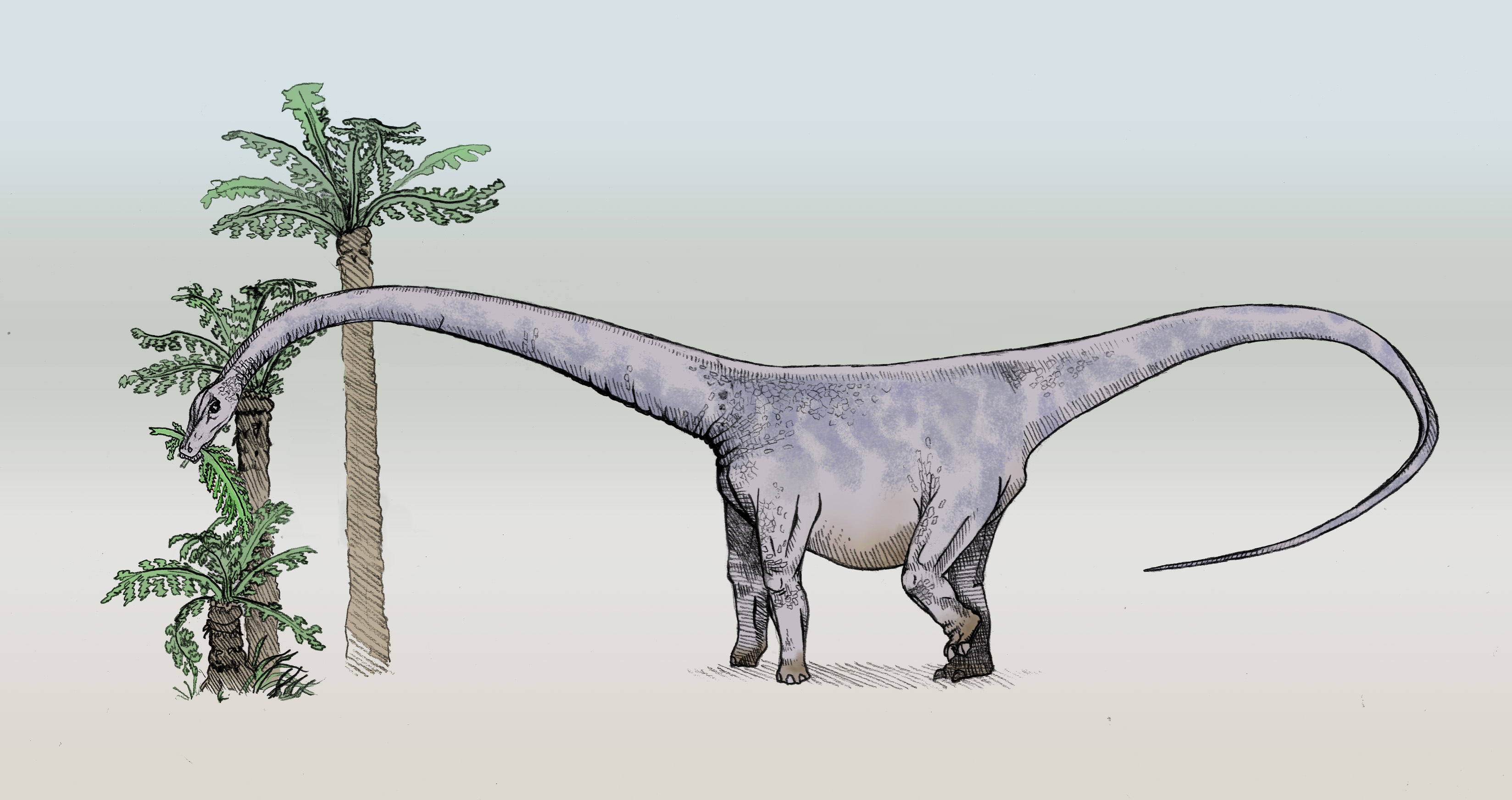- Barosaurus
Taxobox

image_width =250px
name = "Barosaurus"
fossil_range =Late Jurassic
regnum =Animal ia
phylum = Chordata
classis = Sauropsida
superordo =Dinosauria
ordo =Saurischia
subordo =Sauropodomorpha
familia =Diplodocidae
subfamilia = Diplodocinae
genus = "Barosaurus"
genus_authority = Marsh, 1890
subdivision_ranks =Species
subdivision = "B. lentus" Marsh, 1890 (type) "B. africanus" (Fraas, 1908) "B. gracilis" (Janensch, 1961)
synonyms = "Tornieria "? Sternfeld, 1911"Barosaurus" (pronEng|ˌbæroʊˈsɔrəs BARR-oh-SAWR-us) meaning 'heavy
lizard ' (Greek "barys/βαρυς" meaning 'heavy' and "saurus/σαυρος" meaning 'lizard', referring to its heavy neck bones) was a giant, long-tailed, long-necked, plant-eatingdinosaur closely related to the more familiar "Diplodocus ". Remains have been found in theMorrison Formation from the Upper Jurassic Period, along with five othersauropod s: "Diplodocus ", "Apatosaurus ", "Camarasaurus ", "Brachiosaurus " and "Haplocanthosaurus ", as well as the predator "Allosaurus " and armored dinosaur "Stegosaurus ".Description
"Barosaurus" was a large but fairly typical
diplodocid that lived during the Late Jurassic period, around 150million years ago . In fact, in many respects "Barosaurus" was very similar to "Diplodocus" itself, but with slight differences: much taller backbones (vertebra e), a shortertail , and a much longerneck . Probably more than four-fifths of this plant-eater's total length of perhaps 27 m (89 ft) was neck and tail. Presumably it had a small head, although unfortunately no specimen of its skull has been recovered, which is common in sauropods because of the small skull size.The
American Museum of Natural History inNew York City has a skeleton of a mother "Barosaurus" rearing on her hind legs to an enormous height to protect her offspring from an "Allosaurus ". Her head is level with the fifth story of a building. However, whether or not "Barosaurus" could stand that way in life is unknown.Neck
"Barosaurus" was once thought to have held its head like a giraffe. In order to pump blood up to the brain – a height of around 12 m(39 ft), 10 m (33 ft) above the heart – the heart would have had to have weighed about 1.5
tonne s (3,200 lb). The larger a heart, the slower it beats. A 1.5 tonne heart would beat so slowly that the blood would run back down the neck before the next beat. To address this problem a radical theory was postulated that "Barosaurus" had 8 hearts – two in the chest and three pairs in the neck. A more reasonable alternative theory is that, like a giraffe, it had arterialvalve s in its neck. These operate in response todifferential s in fluidpressure , allowing the blood to be pumped up the neck but preventing most of it from falling back down. More recent computer modeling of diplodocids has shown that they probably habitually held their necks more or less horizontally, thus restricting the problem to whether the animal reared up on its hind legs or not.Although it had just 15 cervical vertebrae (neck bones), as in the shorter-necked "Diplodocus", some of them were more than 1 m (39 in) long. The scoops and hollows in their structure mean that the neck as a whole was lighter than it looked.
Discovery and Species
"Barosaurus lentus" is one of the many
sauropod s discovered inNorth America during the "Wild West Dinosaur Hunts" (the "Bone Wars ") of the late 19th century.The remains were initially found by a Mrs E. R. Ellerman in the Black Hills of
South Dakota .Othniel Charles Marsh and J. B. Hatcher collected part of the tail of the skeleton and Marsh named it in 1890. The rest of the remains were protected until Marsh sent George Wieland to collect them in 1898. Some remains of a smaller dinosaur collected at the same time were named (but not officially described) "Barosaurus affinis" in a paper by Marsh one month before his death in 1899.Starting in 1922, three fairly complete "B. lentus" skeletons were dug out of Carnegie Quarry,
Utah , by a team lead by Earl Douglas of theCarnegie Museum of Natural History , inPittsburgh, Pennsylvania . Earlier, he had excavated "Apatosaurus " from the same site, and had been involved in setting up theDinosaur National Monument there in 1915.A partially complete, 24m-long "Barosaurus" specimen was forgotten at the
Royal Ontario Museum (ROM) in Toronto, Ontario. Left for 45 years in storage, the massive fossils were rediscovered in 2007 on various shelves and in drawers throughout the museum's private collection [http://www.rom.on.ca/news/releases/public.php?mediakey=tcycf5vd0p "Massive "Barosaurus" skeleton discovered at the ROM"] ] . It was discovered by Dr. Dave Evans through a reference to a "Barosaurus" specimen at the ROM in a paper by Jack McIntosh. After some investigation it was discovered that there was nearly 50% of the skeleton in the storage areas at the ROM. Research Casting International was commissioned to mount the skeleton for display in the Temerty Galleries at the ROM [http://www.rescast.com/portfolio/show_project.php?PortfolioID=9] . The display, which is the first mounted fossil "Barosaurus" skelton in the world, was unveiled on December 12, 2007.Late Jurassic remains from
Tanzania , originally named "Tornieria africana", are considered by some to be another species of "Barosaurus", "B. africanus", although others disagree with this and consider "Tornieria" a separate, valid genus. J. S. McIntosh, in 2005, noted similarities of the material with both "Barosaurus" and "Diplodocus" (possibly more with the latter) but differences as well. He concluded that further review of the material in Berlin was warranted, before it could be placed in "Barosaurus".A third barosaur species, "B. gracilis", has also been identified from Africa. If "B. africanus" is actually "T. africana", then "B. gracilis" is also likely to be a species of "Tornieria", called "T. gracilis" [http://dml.cmnh.org/1995Aug/msg00582.html] . See the article "
Tornieria " for further discussion."Barosaurus" species
* "B. lentus" (type)
* ?"B. africanus" (probably "Tornieria ")
* ?"B. gracilis" (probably "Tornieria ")"
Nomen dubium ""B. affinis" Marsh (1899) now considered synonymous with "B. lentus".
References
*
Wikimedia Foundation. 2010.
